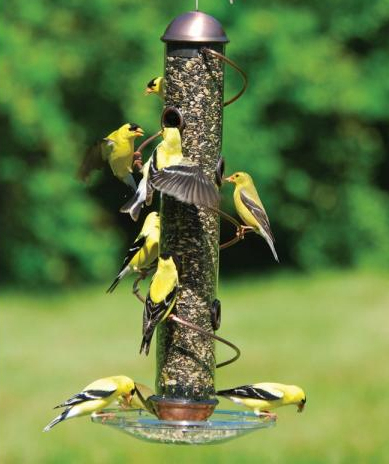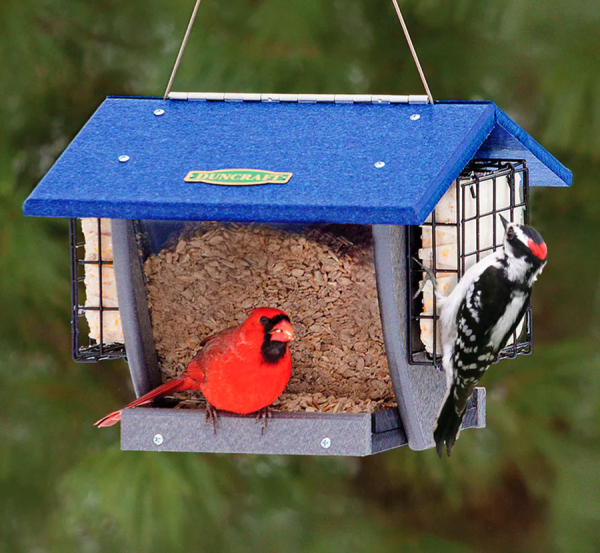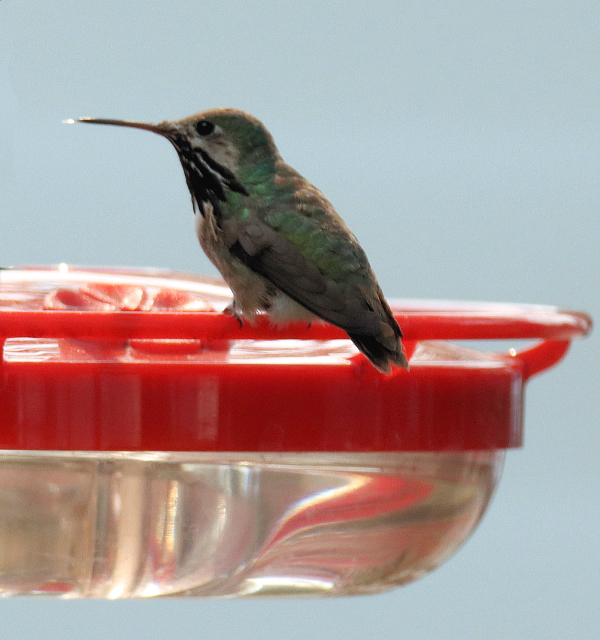 Finches, like these American Goldfinches, appreciate a tube feeder filled with nyjer thistle seed. This feeder is the Copper Spiral Finch Feeder from Songbird Essentials.  Combination feeders are popular among many birders, like this Cardinal Shield Hopper & Suet Feeder from Duncraft.  You may attract an off-course migrant, like the Calliope Hummingbird our editor hosted last September (photo by Paul Konrad). |
It’s an exciting time for birders, and it will get even better during September and October! As we look ahead, what birds would you like to attract during fall migration? What do they eat? There is an exciting period of fall feeding station activities ahead – for you and for birds. We emphasize the idea that there is a chance that some birds that arrive as migrants may be encouraged to stay longer if they find a dependable source of food and fresh water. But to attract birds initially, you will want to offer a variety of food choices, because you never know which birds will stop by next.
With that in mind, we first emphasize providing a “catch all” food: Suet during fall to attract a variety of woodpeckers, nuthatches, chickadees, jays, and other birds that sometimes prefer suet to seeds. Actually, we offer suet throughout the year, but we emphasize it here because some people think of suet as a winter food. We always use hot pepper no-melt suet to avoid squirrels from dominating our feeding station. The hot pepper realistically repels squirrels and other mammals, but doesn’t affect birds; and from a cost standpoint, our suet bill is a fraction of what it was before we switched to hot pepper suet.
At this point in the season, hummingbirds are still king across much of the country, so keep those nectar feeders filled with the fresh sugar-water mixture (1 part white cane sugar to 4 parts fresh water). And thinking ahead, the end of the “hummingbird season” is when there is the best chance that you can attract a wayward western species. The end of hummingbird season is also when a late hummingbird may need a food source most, so don’t take those feeders down early – just after freezing temperatures begin might be a good rule of thumb. And don’t worry, hummingbirds migrate when they are ready, but won’t stay longer than they should because of your feeder. Of course, hummingbirds can be wintering birds in warmer areas of the Sunbelt from southern California to Louisiana, so if it’s not freezing, keep those nectar feeders active.
The biggest change for many birds that have been foraging on insects through the summer is that as temperatures cool, seeds become their primary diet. Even now, finches and cardinals are zeroing in on seeds, as are doves and native sparrows; and soon jays, woodpeckers, nuthatches, titmice, juncos, towhees, thrashers, and more will utilize a reliable source of seeds and other bird foods. Over the years, we have found that it’s best for us to emphasize feeding 2 types of seeds at our feeding station – shelled black oil sunflower seeds – for larger seed-eating birds, and nyjer thistle seeds for some smaller birds such as goldfinches and siskins. However, the American Goldfinches and Pine Siskins that visit our feeding station eat shelled black oil sunflower seeds, so there are times when we don’t use our thistle feeder.
These 2 seed types also provide the best benefits for seed-eating birds, because they have the highest food value, which is exactly why birds prefer them when they are available. We offer shelled sunflower seeds to avoid the need to clean the area around the feeding station – we never have a shell mess, and we aren’t paying for the weight of the shells at the store.
We avoid seed mixes altogether because packaged seed mixes contain a high percentage of “filler” types of seeds and corn, which either ends up uneaten on the ground or the leftovers attract rodents, especially squirrels, plus unwelcome birds including House Sparrows, European Starlings and blackbirds that tend to overpower a feeding station. We suggest avoiding feeding corn in any form if you don’t want to be overpowered by squirrels – plus it has poor food value for most birds. As for the squirrels, we always provide our seeds in squirrel-proof feeders to keep squirrels from dominating our feeding station.
Shelled peanuts are popular with a variety of birds, as long as they don’t attract unwanted birds or rodents. We often mix a small portion of shelled peanut halves or chips with our shelled black oil sunflower seeds, partly because jays prefer them, and we like jays, and other favorite birds like peanut pieces too, especially woodpeckers and nuthatches. We also add a bonus cup of shelled peanut chips to our tray feeder when we fill feeders, just for fun.
Although most orioles have already migrated south in many areas, some Baltimore Orioles winter in Florida, plus Altamira Orioles are full-time residents of southern Texas. In these areas you will want to provide grape jelly and a sliced orange to attract orioles. Some other birds may feed on the oriole foods, such as robins, mockingbirds, House Finches, and you can find out for yourself if these fruits and others are attractive to birds in your neighborhood.
During fall migration, you never know what birds might arrive next on a given day or week. Each year is different, and some species may quickly pass through your area, while others may remain days or weeks; some will become regulars at your feeding station during part or all of the winter. Then too, don’t be surprised if a familiar species doesn’t show up this year (like Blue Jays last year for us), and you may see new birds for extended periods (like the White-winged Crossbills that visited our feeders for weeks the first year we offered black oil sunflower seeds). Enjoy your regular avian visitors and watch for any new birds that catch your eye!
Share your backyard birding experiences and photographs with The Birding Wire at editorstbw2@gmail.com
